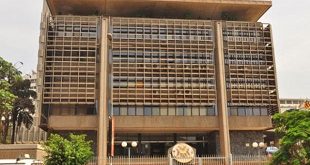
By Isaac Mufumba
He is perched on a heap of second hand clothes in a stall in Jinja central market. He turns his head to have a clearer view of us.
The face and arms bear scars. His left eye, he says, no longer functions. This is Godfrey Dhikusooka, the man who was brutalised at Kirinya government prison on February 16, 2010.
Since then, life has not been the same. I have to be escorted wherever I go because my sight is extremely poor. I cant work like I used to. I feel pain and ache all over, he grieves.
Dhikusooka was arrested on February 10 on charges of child neglect. He was charged in court the following and remanded in Kirinya Prison. On the fifth day in jail, Dhikusooka says, a prison warder entered the cells and started beating him. He was unable to reappear in court February 19. Desperate relatives went to the prison, but they were denied access to him. The ran to the Uganda Human Rights Commission which secured a court order to the prison authorities to produce him.

It was unbelievable. He was brought to us on a stretcher because he couldnt walk. He couldnt see. He talked, but was very incoherent. He was very unstable, says his sister Justine.
When he finally managed to talk to us, he complained of sharp headaches, and pains in the back and stomach, she adds.
Dhikusooka was hospitalised for some time but was later discharged to continue the recuperation at home. He says he was beaten by a warder. But the prisons officials say he was beaten by fellow inmates.
It was a warder called Geoffrey. He slapped me several times before he dragged me into a very cold room where others joined him in beating me. But I didnt notice who they were, Dhokusooka laments. The Officer in Charge of Kirinya Prison Elly Tumuramye denies the accusations.
“He must be confused. He was beaten by intimates,†he said.
The prison officials accuse four inmates Amos Wera Balyo, Asadi Waiswa, Muzaham Mutema and Ismail Bigumba, of carrying out the brutality. On March 04, they appeared in court on charges of assault and causing grievous bodily harm to Dhikusooka.

But Dhikusooka’s case is not an isolated incident. Last month, an inmate in Loro Prison in Gulu, John Okwang, was hospitalised after he was reportedly tortured into paralysis. He had been arrested reportedly upon chewing a love letter meant for a daughter of a prisons officer.
In February, 24-year-old Justine Orach, was reported to have died after he was tortured by a prisons officer. He was said to have been beaten and hanged on a tree as punishment for fighting another inmate.
The Uganda Human Rights Commission (UHRC) has previously named Pece, Murchison Bay and Sentema as prisons where torture of prisoners has been common.
At Pece, a juvenile was tortured and denied access to medical treatment until the regional Human Rights
| Will the new bill stop torture?
On March 11, the US State Department released a report to the US Congress that examined the state of human rights in all countries. According to this report, many countries in the world, for the first time, had registered high levels of human rights abuses on sexual minorities, in freedom of expression, of the press and torture. Uganda was found guilty of arbitrary and politically motivated killings, abductions, mob and ethnic violence, violence against women, children and the torture of suspects and detainees. It should be remembered that in 1986, Uganda ratified the UN Convention Against Torture and Other Cruel, Inhuman or Degrading Treatment or Punishment. In addition, Uganda is a state party to several regional and international human rights instruments and treaties which prohibit torture. Despite all these paper mechanisms, torture continues in Uganda. The existing law does not have a comprehensive definition of what amounts to torture, cruel, inhuman or degrading treatment or punishment. Torture is also not specifically listed as a crime under the penal law. Individuals who commit acts of torture do not take personal responsibility. The liability is rather passed on to the state if the perpetrator is a government official. This has prompted the African Centre for Treatment and Rehabilitation of Torture Victims (ACTV), the Uganda Human Rights Commission (UHRC) and Avocats Sans Frontieres (Lawyers without Borders) to draft a bill to address torture. The Prohibition and Prevention of Torture Bill 2009 provides a comprehensive definition of torture and seeks to make torture a criminal offence. It also provides punishment for the perpetrators, seeks to regulate the use of information obtained by torture and provide for individual criminal and civil responsibility by the perpetrators of torture. Under the Bill, public officials who commit torture will be personally liable for their acts. Superiors who don’t take action against their errant subordinates will also be held liable for the torture acts of the people under their control. The bill defines torture as any act which causes severe pain or suffering whether physical or mental intentionally on a person or group of people. The purpose of torture may include obtaining information or a confession from the person; punishing a person for an act he or she or any other person has committed, or is suspected of having committed or of planning to commit; intimidating or coercing the person or any other person to do or to refrain from doing, any act or for any reason based on discrimination of any kind of the person. The draft law lists acts which constitute physical torture such as beating, kicking and punching, among others. Food deprivation, use of excrement, electric shock, use of cigarate burning, use of pepper, tying, rape and the use of plastic bags are also included. Mental or psychological torture is also provided for in the bill. This includes among blindfolding, threatening a person with bodily harm, confining people in secret detention centres, prolonged interrogation, inflicting shame by stripping the victim naked in public and denial of sleep. By John Njoroge
|
Officer intervened. In Murchison Bay, a prisoner who attempted to escape was tortured to a point of incapacitation. Another inmate in Sentema Prison was tortured on orders of the OC.
The African Centre for Treatment and Rehabilitation of Torture Victims (ACTV) says security forces like the army, prisons and police are perpetrators of torture with the police accounting for 49% of the cases.
According to the UHRC torture cases have tripled since 1997.
There were 21 cases reported in 1997, but the number had grown to 314 by 2008. Between 2003 and 2007, UHRC awarded victims of torture over Shs2 billion shillings in compensation for human rights abuses they had suffered in custody under the security forces. Â
The 2007 UHCR report shows that in 2006 torture cost the government Shs261 million, representing 71% of the annual awards for human rights violations.
According to the UHRC Report 2009, thirty-one out of the 58 cases which were disposed of in 2008 were related to torture and inhuman treatment.
Out of the Shs593 million awarded by the UHRC tribunal, Shs439 million went to victims of torture. A big number of these abuses were committed by the Prisons authorities.
These figures and the recent cases have placed the Uganda Prisons on the spot. There are concerns that some of the Prisons personnel have run amok, unleashing terror on the inmates whom they are obliged to protect. The Commissioner General of Prisons, Dr Johnson Byabashaija, says: “It appears the officers have lost control of their units or have abandoned our mission of humane custody,†Byabashaija wrote in a March 23 administrative circular addressed to all sectional heads of the Uganda Prisons. What went wrong?
The Independent learnt that although the Prisons Act 2006 led to the introduction of human rights in the training curriculum, little or no such sensitisation has been carried out in prisons. The Prisons Public Relations Officer Frank Baine Mayanja says this has been caused by shortage of funds following the increase of prison stations from 48 to 223 without a corresponding rise in the funding.
A source said that although the Prisons was supposed to institute human rights committees in all stations, this has not been done. It was only followed up by the Commissioner General of Prisons in the wake of the recent cases of torture.
Every Prison Unit is to constitute a Human Rights Committee of 5 persons, chaired by the Officer in Charge, which will make a report to the Commissioner General of Prisons quarterly, for the attention of the ACP (Assistant Commissioner of Prisons), Human Rights, Byabashaija wrote in his March 23 administrative order.
Appropriate action will be taken on the officer in charge of the unit irrespective of their involvement in the acts (of inhumane treatment of inmates), he warned.
During Byabashaijas recent visit to Kirinya Prison, an inmate Waisswa Okongo complained that prisoners were being battered by warders and their fellow inmates. He complained that no action was being taken against the errant warders and the one who disabled Dhikusooka.
Mayanja says the accused warder is under investigation and that the Prisons internal disciplinary mechanisms would handle the case appropriately. However, he says torture is not among the 28 offences which can be handled internally under the Prisons Act.
Probably this rampant brutality in the Ugandan prisons and other security detention centres will be sufficiently addressed by the proposed law which seeks to criminalise torture and make it a serious offence punishable by imprisonment and civil compensation.
Under the Bill, public officers who commit acts of torture will be held personally liable for their actions.
 The Independent Uganda: You get the Truth we Pay the Price
The Independent Uganda: You get the Truth we Pay the Price



